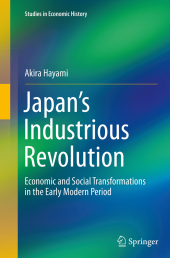 Neuerscheinungen 2016Stand: 2020-02-01 |
Schnellsuche
ISBN/Stichwort/Autor
|
Herderstraße 10
10625 Berlin
Tel.: 030 315 714 16
Fax 030 315 714 14
info@buchspektrum.de |

Akira Hayami
Japan´s Industrious Revolution
Economic and Social Transformations in the Early Modern Period
Softcover reprint of the original 1st ed. 2015. 2016. xix, 130 S. 8 SW-Abb., 1 Tabellen. 235 mm
Verlag/Jahr: SPRINGER, BERLIN; SPRINGER JAPAN; SPRINGER 2016
ISBN: 4-431-56409-8 (4431564098)
Neue ISBN: 978-4-431-56409-6 (9784431564096)
Preis und Lieferzeit: Bitte klicken
This book explains in fascinating detail how economic and social transformations in pre-1600 Japan led to an industrious revolution in the early modern period and how the fruits of the Industrious Revolution are what have supported Japan since the eighteenth century, improving living standards and leading to the formation of the work ethic of modern Japan.
The arrival of the Sengoku Period in the sixteenth century saw the emergence and domination of government by the warrior class. It was Tokugawa Ieyasu who unified the realm. Yet this unity did not give rise to an autocratic state, as the shogun was recognized merely as a main pillar of the warrior class.
Economically, however, from the fourteenth century, currency payments for sh en nengu (taxes paid to the proprietor) became standard, and currency circulation began, primarily in the central region. Under Tokugawa rule, organized domestic coinage of currency began, opening the way to establishing a national economic society. Also, agricultural land was surveyed through cadastral surveys known as kenchi . Land values were converted in terms of rice, so the expected rice yields for each village were assessed, and the lords used this as a benchmark for imposing taxes.
In the sixteenth and seventeenth centuries, Japan experienced a "great transition," and conditions for peasants, agriculture, and farming villages underwent great changes. Inefficient traditional agriculture using peasants in a state of servitude was transformed into highly efficient small-sized farming operations which relied on family labor. As production yields increased due to labor-intensive agriculture, the profits obtained by the peasants improved their living standards. The stem-family system became the norm through which work ethics and even literacy were transmitted. This very change was the result of the "industrious revolution" in Japan.
The book thus presents the framework of the facts of pre-industrial Japanese history and depicts pre-modern Japan from a macroscopic point of view, showing how the industrious revolution came about. It is certain to be of great interest to economists and historians alike.
Part I Socio-Economic Development in Modern Japan.- 1. Analyzing Japanese Economic History.- 2. Before the Formulation of a Socio-Economic History.- 3. The Formulation of a Economic Society.- 4. Economy and Society in the Edo Era.- 5. The Industrialization of Modern Japan.- Part II Characteristics of the Economic Society in the Edo Era.- Part III Economic Development in Modern Japan.- 6. Economic Development in Modern Japan.- 7. Industrious Revolution and Economic Development.- 8. Industrious Revolution v.s. Industrial Revolution.


